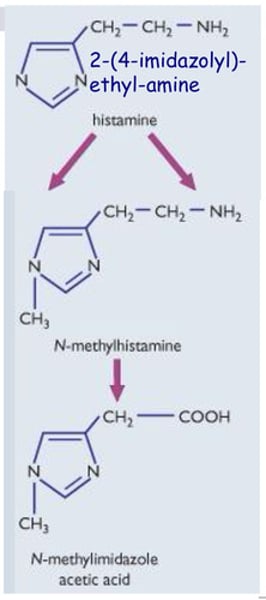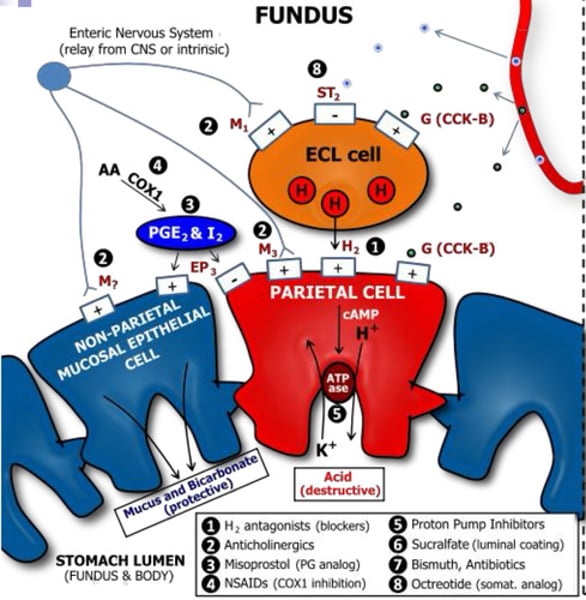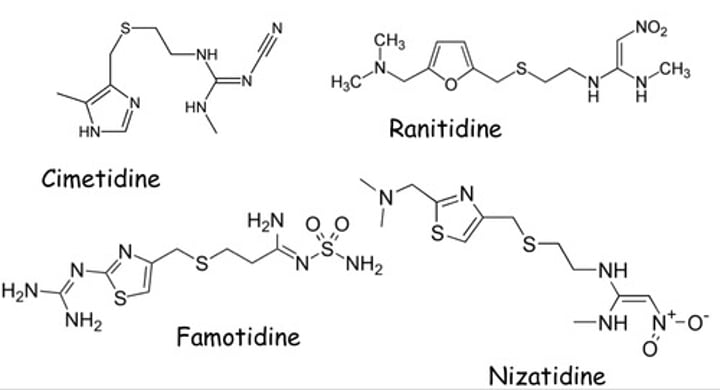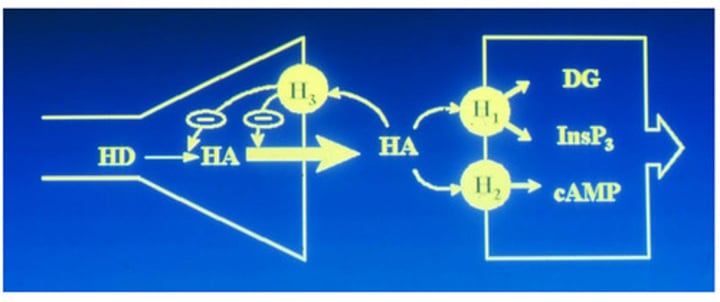RMS - Histamines
1/10
There's no tags or description
Looks like no tags are added yet.
Name | Mastery | Learn | Test | Matching | Spaced |
|---|
No study sessions yet.
11 Terms
Describe the synthesis and inactivation of Histamines
- Histamine is synthesised from the amino acid L-Histidine by Histidine Decarboxylase
- Histamine is inactivated by Histamine N-Methyl Transferase, then Diamine Oxidase

Where is Histamine found in the body?
- Histamine is in most tissues, including the CNS
- Highest concentrations of histamine is in the lungs, skin and GI tract
- Histamine is produced and stored in Mast cells and Basophils, stored as granules of Histamine-Heparin complexes, and released when the cells are activated
Describe the main actions of Histamine
- Smooth muscle contraction = causes bronchoconstriction in lungs and GI tract contractions
- Vasodilation = causes fall in BP and increased vascular permeability (oedema + leakage of plasma proteins)
- Secretion of gastric acid
Describe what occurs in an allergic reaction
- An allergen binds to the IgE antibodies expressed on Mast cells, activating them
- Granulation occurs in Mast cells, and they release histamines, as well as generating prostaglandin-D2 (bronchoconstriction) and leukotrines (oedema) upon activation
- Histamines released activate H1 receptors, causing the symptoms of an allergic response

What are the actions of H1 Receptor activation from an allergic reaction?
- Vasodilation = causes fall in blood pressure (redness observation)
- Increased vascular permeability = causes oedema (swelling observation)(epithelia of blood vessels contract to increase permeability)
- Smooth muscle contraction = causes bronchoconstriction in lungs (hyperventilation observation) and GI tract contractions (cramping, nausea, vomiting + diarrhoea observation)
- Sensitisation of tissue and nerves = causes itching
Describe the properties of H1 Receptor Antagonists
- CNS-penetrating drugs (eg. Promethazine + Chlorpheniramine) = H1 receptors in CNS are involved in wakefulness + blocking causes sedation (histaminergic neurones)
- Peripheral-only drugs (eg. Cetirizine + Loratadine) = non-sedating and can give higher doses
- Side effects = dry secretions + confusion(anti-muscarinic effects of drug, not histamine), hypersensitivity of skin leading to rashes, heart palpitations, and sedation
- Drugs are used for allergies, short term insomnia, and motion sickness (anti-emetic properties from older drugs like Cyclizine)
What are the contraindications for H1 Receptor Antagonist use?
- Sedating antihistamines = cautioned in urinary retention and angle closure glaucoma
- Hepatic diseases = avoid sedating drugs in severe liver disease
- Epilepsy
- Porphyria (non-sedating are safe to use)
- Pregnancy
What are the actions of H2 Receptor activation?
- H2 receptor activation leads to gastric acid secretion, but secretion can also occur from gastrin (protein involved in HCl secretion) and M3 receptors (muscarinic)
- They are found on Parietal cells (found in epithelia of the stomach) and activation stimulates gastric acid production and secretion
- H2 receptors are G-protein coupled receptors and follow a Gs pathway (stimulate cAMP system)

Describe the properties of H2 Receptor Antagonists
- H2 receptor antagonists are used for treating peptic/duodenal ulcers and acid reflux (gastroesophageal reflux disease GERD)
- They are often prescribed with Proton Pump Inhibitors (PPIs) like Omeprazole
- Side effects = not very common but include diarrhoea, dizziness, headaches and muscle pains
- Examples include Famotidine and Cimetidine (inhibits liver P450 so may effect some drugs + androgen receptor antagonist at high doses)

What are H3 Receptors?
- H3 receptors are found in the CNS and are histamine autoreceptors, so activation leads to inhibited histamine release
- H3 antagonists cause increased histamine release, while H3 agonists cause decreased histamine release
- H3 receptor activation can also affect neurotransmitter release in the CNS like Noradrenaline, monoamines, Acetylcholine and neuropeptides

What are H4 Receptors?
- H4 Receptors are a histamine receptor type that was most recently discovered, with similar structure to H3 receptors
- Activation of H4 receptors have been seen to cause itching, and the only agonist discovered is anti-psychotic Clozapine
- They have been found on a number of immune cells like mast cells, macrophages, and granulocytes
- Their function is unknown, but believed to play a role in the immune system and in inflammation